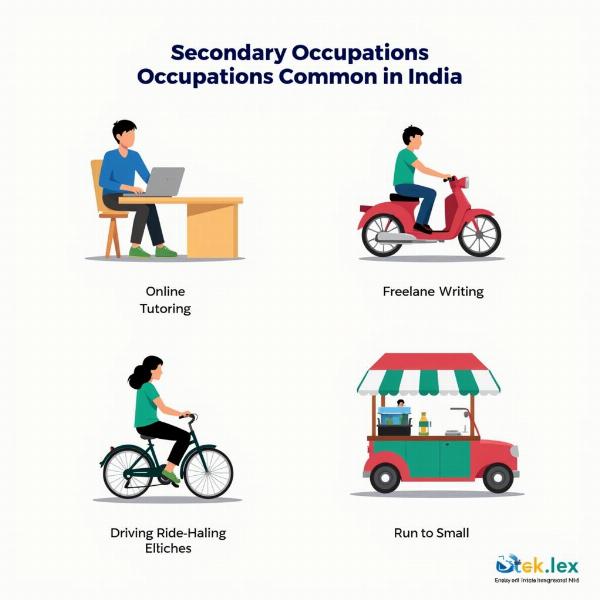Understanding the concept of a secondary occupation is crucial in today’s dynamic economic landscape. “Secondary occupation meaning in Hindi” is a common search term, indicating a growing interest in diversifying income streams and exploring alternative career paths. This article will delve into the various nuances of secondary occupations, their relevance in India, and the corresponding terminology in Hindi.
What Does Secondary Occupation Mean?
A secondary occupation refers to any work undertaken in addition to one’s primary job. It can be part-time, full-time, or even seasonal, depending on the individual’s circumstances and goals. This supplementary work can range from freelance writing and online tutoring to driving for a ride-hailing service or running a small business. The motivations for pursuing a secondary occupation are diverse, including supplementing income, developing new skills, exploring passions, and achieving greater financial security. For many in India, a secondary occupation provides a crucial safety net, particularly in times of economic uncertainty.
 Examples of Secondary Occupations in India
Examples of Secondary Occupations in India
Secondary Occupation in Hindi: विभिन्न व्यवसाय (Vibhinn Vyavsay)
The Hindi term for secondary occupation is often expressed as द्वितीयक व्यवसाय (Dwitiyak Vyavsay), literally translating to “secondary occupation.” Other terms like अतिरिक्त रोजगार (Atirikt Rozgar), meaning “additional employment,” or सहायक व्यवसाय (Sahayak Vyavsay), meaning “supplementary occupation,” are also frequently used. Understanding these terms can be beneficial when researching job opportunities, filling out official forms, or discussing career prospects within the Indian context.
Why is Secondary Occupation Important in India?
In a rapidly evolving Indian economy, a secondary occupation can offer numerous advantages. It provides an additional income source, contributing to financial stability and allowing individuals to meet rising living costs. It also fosters skill development and allows individuals to explore different career paths. Furthermore, a secondary occupation can empower individuals, particularly women and those in rural areas, by providing them with economic independence and a sense of purpose.
Different Types of Secondary Occupations
The landscape of secondary occupations is diverse and constantly evolving. Here are some examples:
- Freelancing: Freelancing encompasses a wide range of skills, including writing, editing, graphic design, web development, and online marketing.
- Gig Economy Jobs: These include driving for ride-hailing services, delivering food, and completing tasks on demand-delivery platforms.
- Part-Time Jobs: These can be in various sectors, from retail and hospitality to education and healthcare.
- Home-Based Businesses: These can range from selling handmade crafts to providing online tutoring services.
How to Find a Secondary Occupation
Finding a suitable secondary occupation requires careful consideration of one’s skills, interests, and available time. Online platforms, job portals, and networking within your community can be valuable resources.
Conclusion: Embracing the Potential of a Secondary Occupation
In a world characterized by economic fluctuations and evolving career paths, embracing the concept of a secondary occupation can be a strategic move towards financial security and personal growth. Understanding the “secondary occupation meaning in Hindi” and exploring the diverse opportunities available can empower individuals to create a more secure and fulfilling future.
FAQs
- What is the most common Hindi word for secondary occupation? Dwitiyak Vyavsay (द्वितीयक व्यवसाय) is a commonly used term.
- Why are secondary occupations becoming more popular in India? They offer increased financial security and opportunities for skill development.
- Where can I find secondary occupation opportunities? Online platforms, job portals, and networking within your community are good starting points.
- Is it legal to have a secondary occupation in India? Yes, as long as it doesn’t conflict with your primary employment contract.
- What are some popular secondary occupations in India? Freelancing, gig economy jobs, and home-based businesses are popular choices.
- What are the benefits of a secondary occupation? Increased income, skill development, and greater financial security are key benefits.
- How do I balance a primary and secondary occupation? Effective time management and prioritizing tasks are essential.
Meaning-Hindi.in is your trusted partner for all your Hindi translation needs. We offer a wide range of professional translation services, including business and commercial document translation, legal and certified translation, technical and user manual translation, website and localization services, educational and academic translation, and specialized industry translations. Our expert team ensures accurate, culturally sensitive translations delivered promptly. Contact us today at [email protected] or call us at +91 11-4502-7584 to discuss your project requirements. Meaning-Hindi.in is committed to providing high-quality language solutions for individuals and businesses alike.